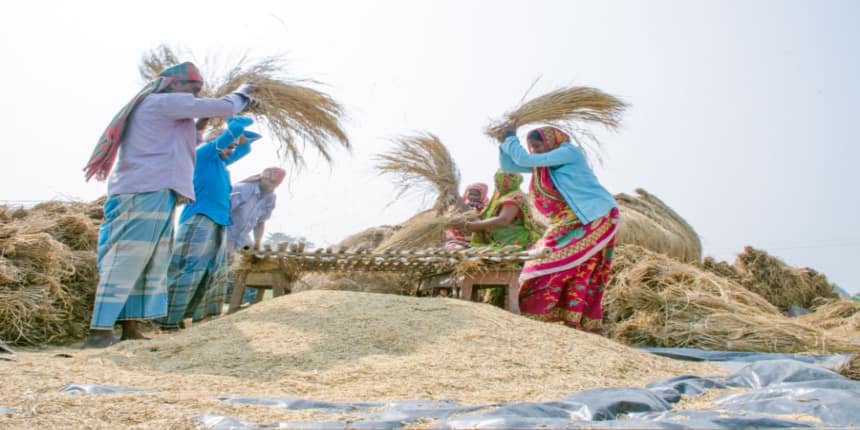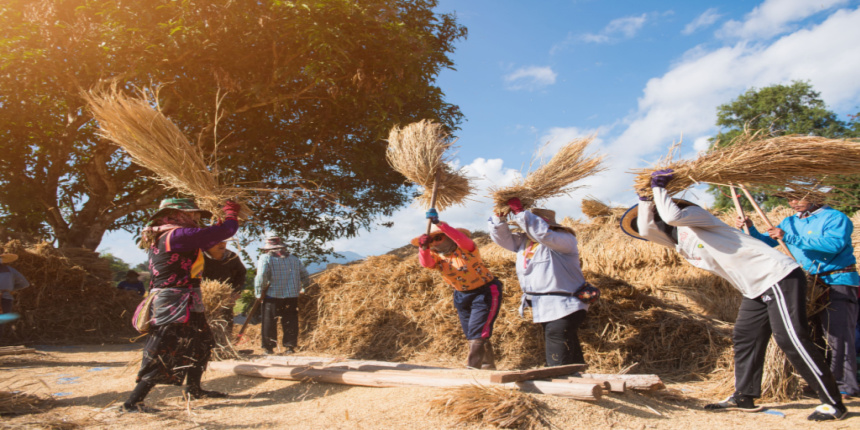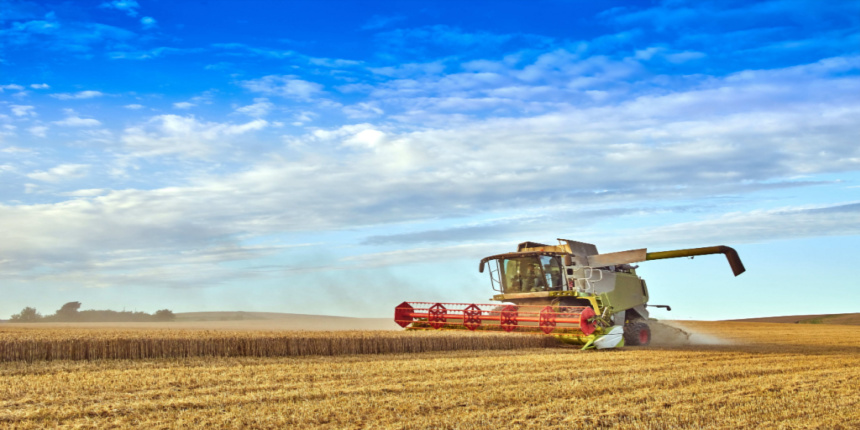What is threshing? - Winnowing, Definition, FAQs
How do we separate the grains from the plants after harvesting? What makes the difference between just cutting the crop and efficiently extracting the edible seeds? And why do farmers use machines or tools for this seemingly simple task? We will get all these answers by reading this article on threshing. But now the question arises, what is threshing? Threshing is the process of separating grain, the part which edible, from the straw or husk (the inedible part) after crops like wheat, rice, barley, and oats have been harvested.
This Story also Contains
- What Is Threshing?
- Methods Of Threshing
- Threshing And Winnowing
- What Are The Differences Between Threshing And Winnowing?
- Some Solved Examples

With the development of agricultural technology, threshing machines were soon developed to make this work much quicker. A threshing device separates the food grain from the stalks and husks, which mechanically removes the grain from the stalks, increasing productivity, and saves time and labour, along with grain quality in common, and reduces losses and crop waste. Modern threshers are capable of handling diverse crops like wheat, rice, barley, and maize, and have become a staple for the contemporary farmer.
What Is Threshing?
The process used by the farmers working in the agricultural sector for separating grains from the stalks after the harvesting process is done. In ancient times, it was done by beating the grain with a stick on any clean and hard surface, and it also needed great effort. Now the threshing is done with the help of threshing machines.
Do you know what is threshing means in Hindi? The meaning of threshing in Hindi is ‘Taadana’. Synonyms for it are beating, separating, harvesting, and many more. This means It is a process that is used for the separation of grain from the stack where it grows. By the process of threshing, the edible portion of that crop is loosened, and the non-edible portion, which is the fiber portion, is not loosened. This process is done before winnowing and after harvesting. During ancient times, this process was done by beating with a thrash manually. And after which the grains were collected and to remove the straw, winnowing is used. During the winnowing process, the air current is blown and it will remove the lightweight particles from it, and the remaining portion will contain only the grain particles.
Later Andrew Meikle invented the threshing machine. It made the process easy. It consists of a spinning chamber of wooden mixtures and is supported by piles of grain. Threshing machines work on the theory of the Meikles machine. In the threshing machine, the straw remaining is removed by which it contains a sawtooth-like drum, which forces the remaining waste and the grain through the set of rollers through a strainer that will then separate the chaff from the grain before the process of winnowing. Now, with the help of combined harvesters, it will do the process of harvesting, threshing, and winnowing. The threshing machine price is not affordable for small and marginal farmers. So without purchasing the whole machine they use it and pay money according to the time taken in the whole threshing process.
Threshing Process

Methods Of Threshing
There are some other examples of threshing, like handpicking the pebbles, broken grains, and insects that are found in the rice, and removing some pulses and wheat. Threshing is also used for the separation of seeds from the harvested stalks.
1. Manual Threshing
2. Mechanical Threshing
1. Manual Threshing
Manual threshing is the traditional method used to separate grains from crops, and it is often done by hand using simple tools or even by using animals. It includes the Flail Method, trampling, and manual beating. It has various advantages like Low Cost, Accessibility, Cultural, and Traditional.
2. Mechanical Threshing
Mechanical threshing uses modern machinery to separate grains from the husks quickly and efficiently. It is the standard method used in industrial or large-scale farming operations. It includes Threshers: A thresher machine uses rotating cylinders or rollers to agitate the harvested crop and separate the grains from the plant material. Combines (Combine Harvesters), which perform multiple tasks, cutting, threshing, and separating—all in one operation. These machines combine the harvesting and threshing processes, saving time and labor. and Tractor-Pulled Threshers. These are smaller-scale threshers that are attached to a tractor. The tractor powers the threshing operation, making it quicker than manual methods but not as fast or large-scale as combine harvesters. The image of thresing machine is given below:

Threshing And Winnowing
The very important harvester function is threshing and grain loss and the degradation of a crop will significantly affect the threshing process. There are four types of principles are associated with the threshing process that are scratching, scrapping, combing, and grinding. Through a subsequent combing process, the grain loss from the cleaning process can be controlled. After the harvesting browsers threshing is done and immediately after the threshing process winnowing is done for the separation of chaff from the grain.
The main difference between threshing and winnowing can be given as. The threshing process involves the beating out of grains from the stem of the plant. While winnowing involves the separation of grains from the chaff. Winnowing is a process done after the threshing process is completed with the help of wind.
What Are The Differences Between Threshing And Winnowing?
Both threshing and winnowing are used for agricultural purposes for the removal of unwanted substances from the grain. The main difference between threshing and winnowing can be explained as.
- The threshing process involves the beating out of grains from the stem of the plant. While of winnowing involves the separation of grains from the chaff.
- Only when the threshing process is completed winnowing process start.
- The winnowing process can be done with the help of wind, while threshing is done by striking the harvested crops by using a hard surface.
- Threshing is done with the help of a thresher machine, and winnowing is done with the help of a winnowing machine. Two different machines are used for the process even though their purpose is the same, which is the removal of the unwanted substance.
- And also, winnowing is a process that is done immediately after the threshing process.
Also read
Some Solved Examples
Question 1: What is the main purpose of the threshing process in agriculture?
A) To separate seeds from the soil
B) To remove dirt from the harvested crops
C) To separate the grains from the husks or straw
D) To store the harvested crops
Solution:
Threshing is the process that separates the edible grains from the non-edible parts (like husks and straw) of the crop after harvesting.
Hence, the correct answer is option (C): To separate the grains from the husks or straw
Question 2:
In manual threshing, what tool is commonly used to beat the harvested crop to separate the grains?
A) Plough
B) Flail
C) Harrow
D) Tractor
Solution:
A flail is a traditional tool consisting of a long stick with a shorter one attached at the end by a chain. It is used to beat the crop and separate the grains from the straw.
Hence, the correct answer is option (b) flail
Question 3: Which of the following methods is commonly used in mechanical threshing?
A) Flail method
B) Trampling by animals
C) Combine harvester
D) Beating with a stick
Solution: A combine harvester is a machine that not only cuts the crops but also threshes and separates the grains from the straw, making it an essential tool in large-scale farming.
Hence, the correct answer is option (C) Combine harvester
Frequently Asked Questions (FAQs)
Threshing separates the grains from the stalks and husks, while winnowing separates the grains from lighter impurities like chaff and dust after threshing.
The threshing machine greatly reduced manual labor and time, minimized grain loss, and increased the efficiency of harvesting, which allowed farmers to process large quantities of crops quickly.
Threshing is a crucial step that prepares harvested crops for further cleaning, drying, storage, and sale by removing the grain from the plant material.
Crops like wheat, rice, barley, maize, millet, and pulses typically undergo threshing and winnowing.